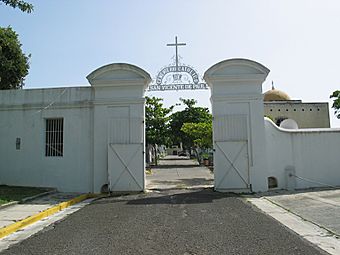Cementerio Católico San Vicente de Paul facts for kids
Quick facts for kids |
|
|
Cementerio Catolico San Vicente de Paul
|
|

The cemetery entrance gate in 2010
|
|
| Location | Alma Sublime Street Ponce, Puerto Rico |
|---|---|
| Area | 9.2 acres (3.7 ha) |
| Built | 1901 |
| Architectural style | Classical Revival, Spanish Revival, Art Deco |
| NRHP reference No. | 88001249 |
| Added to NRHP | 25 August 1988 |
The Cementerio Católico San Vicente de Paul (which means Saint Vincent de Paul Catholic Cemetery in English) is a special cemetery in Ponce, Puerto Rico. It's known for being the only cemetery in Puerto Rico with unique underground burial spaces. These spaces are built like a basement, making it feel a bit like a catacomb, which is an underground burial place. The cemetery is named after Vincent de Paul, a French Catholic priest who helped many poor people. This historic site was added to the U.S. National Register of Historic Places in 1988.
Contents
Where is the Cemetery Located?
The Cementerio Catolico San Vicente de Paul is found near Puerto Rico Route PR-123 in an area called Magueyes Urbano. The road used to be known as PR-10, so you might see that number in older papers. The cemetery is built on a hill, so the ground slopes quite a bit.
A Look at the Cemetery's History
Around the year 1900, Catholic priests in Ponce decided to build a private cemetery. It was officially blessed on August 15, 1901, and then opened for burials. Rich families in the area bought burial plots for $60. They built amazing mausoleums and graves there. Today, the cemetery is surrounded by many homes and buildings.
Why This Cemetery is Special
Ponce, located on the southern coast of Puerto Rico, was a very wealthy city in the early 1900s. At that time, this Catholic cemetery offered a special place for the rich to bury their loved ones. Because of this, almost all the tombs are beautifully designed and decorated.
You can see some of the best examples of early 20th-century funerary architecture in Puerto Rico here. Many tombs feature marble sculptures brought from Italy, Spain, and other parts of Europe. Most of the tombs are also covered with a stylish pink marble, which is very common in Ponce.
The largest mausoleums belong to the wealthiest families in southern Puerto Rico. They are grand examples of monumental architecture from that time. Some famous families with mausoleums here include the Serralles, Mercado, Toro, and Valdivieso families.
One unique thing about this cemetery is its special underground burial niches. These are built like a basement, allowing burials to happen below ground. This design gives the feeling of a catacomb, which is very rare in Puerto Rico.
How the Cemetery is Designed
The cemetery has a simple entrance gate. It's an iron gate with two stone pillars on either side. Even though it's a Catholic cemetery, it never had a chapel at the entrance or anywhere else inside.
The cemetery's layout follows an old Spanish tradition. It has two main paths that form a cross shape. The rest of the cemetery is laid out in a square grid pattern. Since the cemetery is on a steep hill, some of the paths leading up to graves are actually stairs.
The main path ends at a large pantheon for the priests of the Paul order. This impressive tomb combines sculptures with its architecture. It has a special feature called a baldachino, which is a canopy that protects both the altar and the tomb. The Baroque style of this structure is clear in its grand size and complex design.
Larger tombs are placed along the main and secondary paths. Other graves then spread out from these main areas. Many of these larger tombs are mausoleums built in different architectural styles, from classical revival to Art Deco.
Cemetery Architecture
The cemetery's style is known more for its buildings than its sculptures. The quality of construction is so good that it's considered a "posthumous mansion" for those buried there. Many mausoleums are made of marble, showing how wealthy the families buried there were.
Some mausoleums are especially important for their architectural beauty. These include the Serralles family mausoleum, which has a central chapel on a raised platform. The Mario Mercado Montalvo family mausoleum also sits on a raised platform. The Valdivieso family mausoleum is another notable example. The Toro family mausoleum and the Chardon family mausoleum also have funerary chapels, but they are not raised on platforms.
What Happened Recently?
Over time, many of these grand tombs have been left empty. Some families moved their loved ones to the Cementerio Civil de Ponce. This happened partly because it was very expensive to maintain the tombs. Also, the cemetery had strict rules, like not allowing non-Catholics to be buried there. Some families wanted to stay together, so they moved their relatives to the other cemetery. As a result, some graves are now abandoned. The cemetery administration cannot sell them because they are private property, even if the owners are no longer interested.
- National Register of Historic Places photographic file
See also
 In Spanish: Cementerio católico San Vicente de Paul para niños
In Spanish: Cementerio católico San Vicente de Paul para niños



